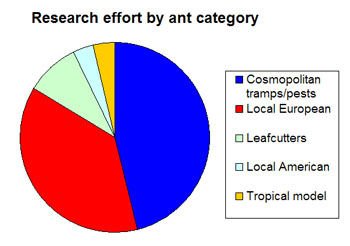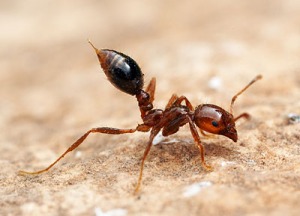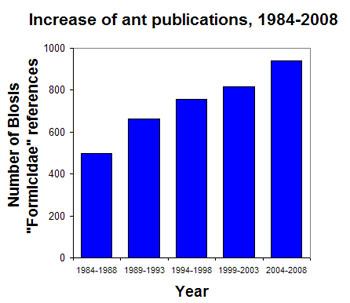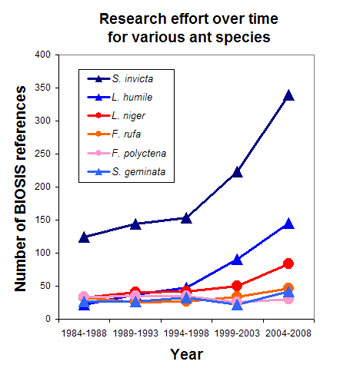
Figure 1. For the 32 most-studied ant species, the percentage of publications 1984-2008 in various contexts.
In thinking about where the myrmecological community ought to devote resources in the age of genomics, it occcured to me that putting some numbers on where researchers have previously concentrated their efforts might be useful. So I went to BIOSIS previews and quantified the number of publications in 5-year intervals from 1984 to 2008 recovered under searches for various well-studied ant species (methods and full data here). Here's what I found:
Number of publications 1984-2008
on ant species with > 50 studies
| species | #pubs |
| Solenopsis invicta | 984 |
| Linepithema humile | 343 |
| Lasius niger | 250 |
| Formica rufa | 167 |
| Atta sexdens | 163 |
| Formica polyctena | 160 |
| Solenopsis geminata | 151 |
| Myrmica rubra | 142 |
| Monomorium pharaonis | 121 |
| Atta cephalotes | 112 |
| Oecophylla smaragdina | 111 |
| Solenopsis richteri | 110 |
| Pheidole megacephala | 104 |
| Tetramorium caespitum | 93 |
| Formica fusca | 92 |
| Pogonomyrmex barbatus | 87 |
| Lasius flavus | 87 |
| Wasmannia auropunctata | 79 |
| Atta laevigata | 79 |
| Pogonomyrmex rugosus | 79 |
| Myrmica scabrinodis | 70 |
| Formica lugubris | 69 |
| Acromyrmex octospinosus | 67 |
| Formica cunicularia | 65 |
| Messor barbarus | 62 |
| Myrmica sabuleti | 62 |
| Anoplolepis gracilipes | 60 |
| Formica sanguinea | 60 |
| Formica exsecta | 60 |
| Formica pratensis | 60 |
| Eciton burchellii | 54 |
| Tapinoma melanocephalum | 54 |
Methods and data (in Excel 2003 format)

Fig. 2. Solenopsis invicta, the most-studied ant
32 ant species received more than 50 studies each over the 25 year period. Predictably, the world's most-studied ant is the fire ant Solenopsis invicta (Fig. 2), a species native to southern South America that has become a major pest in warmer climates around the world. The famous fire ant is followed by the Argentine ant Linepithema humile, a similarly pesty ant from the same region. But I was surprised by the rest of the list.
While a great many of the top ants were cosmopolitan tramps and pests, a high number of species (15) were European, mostly unremarkable except for their shared regional temperate/boreal distribution. It seems that a concentration of myrmecologists in a region with relatively low ant diversity has produced a high number of studies per species. Conversely, even though North America hosts plenty of myrmecologists, the North American fauna does not receive a similar density of attention. Perhaps North American myrmecologists tend not to study local native species, or they dilute their efforts across a broader array of ants. Or they just publish less. As for myrmecology in the rest of the world, they either don't register as much work or they are spread thinly across a rich tropical diversity.
An unsurprising result is the increase in the number of ant publications over the time period (Fig. 3). Biology has boomed in recent decades, both in funding and in activity, and myrmecology is no exception. The most recent interval shows a publication rate nearly double that of the first interval. In 2004-2008, 939 studies referencing "Formicidae" were published. That's 2.7 studies released every day- more than even the most diligent myrmecologist can reasonably digest.

Fig. 3. Ant publications increased during the 25-year period
The increase in publications appears to be related to an expansion of interest in species that are trampy or invasive. In 1984-1988, 39.7% of publications referenced invasive or tramp ants, while in 2004-2008 that percentage increased to 54.9%.

Fig. 4. Publications over time for the three most studied tramp ants (triangles) and local European species (circles).
I have mixed feelings about the ants that the ASU genome project will target (Harpegnathos saltator [18 studies], Camponotus floridanus [41 studies], and Pheidole sp. [104 studies for P. megacephala]). On one hand, the new genomes will spur tremendous interest in some heretofore neglected species. On the other hand, we're staking genomes into some poorly-explored areas of myrmeco-space. As we don't know much about these ants, we may at first be limited in immediate applications for the genomes.
32 ant species represent less than 0.3% of the 12,000 described species. In spite of what appears to be a rather impressive rate of scientific discovery in the ants, it's worth bearing in mind that the vast majority of ants have never received any study beyond the cursory work required to assign them a latin name. Most research remains concentrated on a very few species that are rather unrepresentative of ants as a whole, being either opportunistic tramps or cold-climate endemics. For the sake of a bigger picture we'd do well to figure out how to channel resources to myrmecologists working in, say, Colombia or Indonesia.
Finally, I would like to add the caveat that this post is not a proper scientific study. These are preliminary figures generated on the fly from a few hours' worth of tabulation, they were not subjected to any statistical analyses, nor have they been replicated or peer-reviewed. I present them for heuristic purposes only.

I'm not surprised either by these preliminary results. I did know that RIFA was number one in the world but I didn't know that there are so many articles published about it the last 5 years, about 1 every 5 or 6 days!
About the Europeans I'm surprised because I expected that the New World was more studied than Europe the last years. Maybe the Europeans concentrate more on their own continent and the Americans on areas outside their home.
It is also sad that tramp species are more studied than local ants in a big part of the world. Local ants can include very interesting species that can be gone before they are studied. Who are to blame for that? The most studied tramp species. It's a little circle running around.
Sadly, no inquilines on the list .....